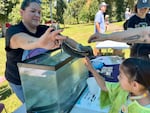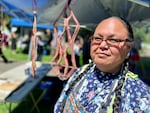
Yakama Nation biologist Dave’y Lumley shows Ava McJoe, 8, an adult lamprey at the Yakama Nation's Willamette Falls lamprey celebration.
Courtney Flatt / Northwest News Network
On the banks of Oregon’s Willamette River, cooks grilled up food for hundreds of people. It’s a summertime barbecue with a twist.
The smell of sizzling lamprey drew people to a tent recently where Yakama Nation citizens placed 3- to 4-inch chunks of the fish onto the grill.
Evans Lewis manned the station.
“Just clean them, rinse them off and throw them on,” Lewis said.

Yakama Nation member Evans Lewis grills lamprey.
Courtney Flatt / Northwest News Network
Smoke filled his eyes as he tested the temperature of each piece of lamprey.
Pacific lamprey have served as an important food source for tribes since time immemorial.
“I think it's delicious. So they're very oily. So I put it on a grill. I just gut them, garlic salt and then just put them on the grill because they’re very oily. My grandpa likes to bake them,” said Dave’y Lumley, a biologist with the Yakama Nation Fisheries Pacific Lamprey Project.
Lamprey are mysterious, eel-like fish. They’ve been around for hundreds of millions of years — but in the last century they’ve run into trouble, rapidly disappearing from Northwest waters. They play an important role in the ecosystem, feeding wildlife from eagles to bears and delivering marine nutrients into the freshwater ecosystem.
Lumley said these ancient fish have lived through the time of dinosaurs, ice ages and floods. They have fed Indigenous peoples since time immemorial. They have been an integral part of the ecosystem and now they need help.
That is why the Yakama Nation celebrated the return of the lamprey from the ocean. Tribal fishers often catch lamprey at Willamette Falls. Lumley said they bring the fish back for celebrations and for elders and other tribal citizens who are unable to fish.

Yakama Nation member Elaine Harvey demonstrated how to filet lamprey and hang it to dry for jerky.
Courtney Flatt / Northwest News Network
“Traditionally we dry all our food. A long time ago there weren't freezers and jars and all that stuff. So, we had to dry all our food,” said Elaine Harvey, a Yakama Nation Rock Creek Band citizen.
Harvey demonstrated how to filet and dry lamprey to make jerky.
“So, these will take a while to dry, maybe a week or so. It depends on how much wind you get. If you have a lot of wind, it dries a lot faster,” Harvey said.
The fish don’t have any bones, which factors into tribal legends, said Yakama Nation biologist Ralph Lampman.
“They’re gambling and the lamprey kept losing and losing, so they had to bet something. All he had left was his bones and his fins,” Lampman told spectators at his informational booth. “In the end he lost and suckerfish got all the bones that lamprey gave away, so that’s why (suckerfish) have so many bones.”
This year, scientists said they have seen the best lamprey return in years.
“It was kind of a really high number early in the season. So we’re hoping that it’s not just an early run but it’s going to continue to stay strong,” Lampman said.
For more than a decade, tribes have given lamprey truck rides from the lower Columbia River to streams that are hard for the fish to reach. A recent study from the Nez Perce Tribe shows the translocation is working.
Several dams have lamprey passage structures — but not all.
“We've developed lamprey passage structures which are a series of shoots and ramps or even like a vertical wetted wall. We have vertical wetted walls in there so they can hop an entire level,” Lumley said.
Another problem for young lamprey, Lumley said, are fish screens. The screens are supposed to keep salmon and other large fish out of irrigation pipes, but young lamprey are so tiny that they get sucked right in.
Lamprey don’t start to get bigger until they reach the ocean.
Usually, tribes split how many lamprey they each transport around the dams. This year, Lumley said, lamprey are returning in such high numbers, they can bring as many fish as they need.
“We are at capacity right now. So we need to start releasing things, and then we can go get more fish,” she said.

Miracle Edmiston, 14, and her brother, Eagle, 12, searched Willamette Falls for lamprey. Students from the Confederated Tribes of the Umatilla Indian Reservation hoped to gather lamprey before the celebration officially began.
Courtney Flatt / Northwest News Network
A short boat ride up the river, water splashes over Willamette Falls. Students from the Confederated Tribes of the Umatilla Indian Reservation hop from slippery moss-covered rock to rock. To make it closer to the falls, they climb across fallen tree branches and swim across a small pool of water.
“You gotta get used to the slipperiness and the rocks and stuff. It's honestly really cool,” said 14-year-old Miracle Edmiston.
Miracle and her brother, Eagle, searched for lamprey. Willamette Falls is one of the best places for tribal fishers to catch lamprey, tribal members said.
“It’s surreal, honestly,” Miracle said. “When you're out here, you don't really focus on anything else. You're just here in the moment and then the feeling of the water is really nice and just looking at the nature around us is awesome.”
The water is pretty low, so the kids don’t find any lamprey this time. They say they’ll be back again.
Just across the park, Lampman wore a lamprey hat as he rapped to the crowd about lamprey survival.
“Let’s all get dressed, roll up our sleeves and do our best to make this lamprey revival a success. Lamprey deserve life, not death,” he sang.
People held hands, forming a line for a traditional intertribal “eel dance.” Young and old snaked their way around the grassy dance floor, imitating the lamprey swimming style.
With a little bit of luck and a lot of work, the tribes say they hope lamprey will continue to be around for the youngest dancers and for generations beyond.
“We are seeing a difference. I feel like we’re making a difference,” Lumley said.